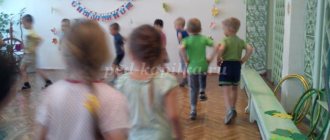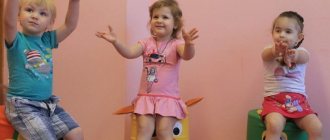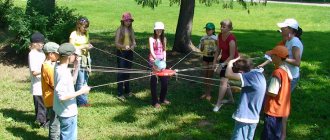Introduction.
Currently, in the modern changing world around us, in the world of information and communication technologies, the task of introducing the younger generation to various sports comes to the fore.
A large role in introducing young people to sports, who are increasingly tied to computers and mobile phones, is given to outdoor mass sports games.
I consider the purpose of working on the abstract to be to consider the concept of an educational task, to consider the concept of outdoor play, types of outdoor games, as well as the educational significance of outdoor games.
After all, as you know, it is the game that has a great influence on mental development. Acting with objects, a person begins to operate in a conceivable, conventional space. Gradually, play activities are reduced, and we begin to act internally, mentally.
Middle and high school students
Older students will be interested in different games than primary school students. From a pedagogical point of view, it is more difficult to captivate a teenager than younger children.
This task will be easier to cope with if new games are introduced that keep up with the times. Games in nature are especially useful for schoolchildren, because ordinary walks will not provide the necessary physical activity.
Lincoln's snowball blunder
High school students will also want to play an exciting game with a popular plot. Winter fun will captivate every child.
Features: carried out in winter, when there is enough fresh snow and not severe frost, there is sufficient space outside.
Details: a plastic bottle with colored rice (rice is painted with food coloring) will imitate a bottle of holy water; a picture depicting a city map, red and blue ribbons for each participant.
What else to read: A funny “Mousetrap” for the little ones
Story for the plot: President Lincoln fights werewolves. The werewolves are sitting in the fortress, the president and his assistants are in the apartment. They decide to go fight evil. The object of the struggle is a map of the city, which the werewolves keep in their fortress.
Organization of the game:
- The day before you need to make 2 fortresses at a distance of 9-10 m from each other, the height of a child.
- Teams of werewolves, Lincoln and his assistants are selected.
- Each participant marks himself with a ribbon: the werewolves are red, the wrestling team is blue.
- The werewolves take a position in their fortress, and the map is located in this fortress. Werewolf weapons: snowballs.
- The President and his team occupy the second fortress-apartment. Their weapons: a bottle of holy water (dyed rice) and snowballs.
- Lincoln jumps up so that the werewolves can see it and waves his hand, saying: “I won’t give you an easy life, but I’ll show you an example. The only way for you to save yourself is to give the card to us!”
- After this, the werewolf hunters try to run to their opponents' fortress and take the map. Werewolves are trying to break into the president's apartment.
- If a snowball hits a member of one of the teams, he is eliminated from the game for three minutes. When holy water hits a werewolf, he is knocked out for 10 minutes.
- The game ends when the president's team has captured the map, or if a third of the werewolves have entered the apartment.
Relay race
Relay races are known in every school; they are held in physical education classes. Conducting relay races improves physical fitness and strengthens the competitive spirit. General principle:
- Invite children to divide into teams.
- Form teams into columns at the starting line.
- On the command “March!” the captain runs (jumps) to the flag, touches it with his hand and returns to the team.
- Pats the next person in the column on the shoulder, who performs the same actions as the captain, and so on.
- The winner is the team whose last link returns to the starting line first.
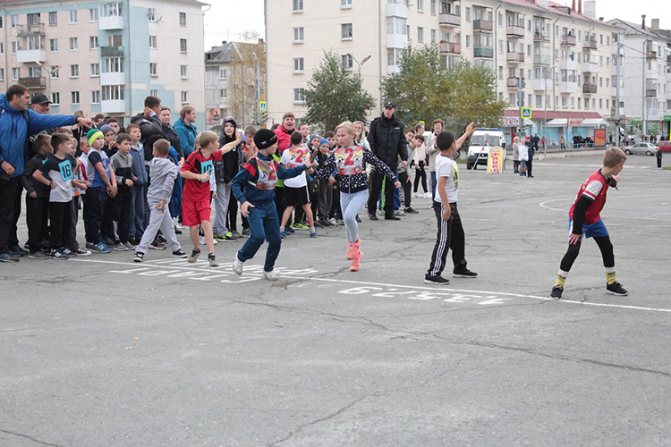
Other games
High school students do athletics and run short distances. But still, they will play football with great pleasure. The purpose of outdoor play is not only to improve physical characteristics, but also to instill a lifelong love of sports.
The importance of outdoor games for health.
In addition to educational tasks, outdoor games have a beneficial effect on the health of the body as a whole. After all, the main task of outdoor games is to strengthen the health of those involved and promote their proper physical development; promote the acquisition of vital motor skills and abilities and improvement in them; development of reaction, development of dexterity, knowledge of movement and new capabilities of the body.
All the variety of outdoor games and their various movements and actions, usually performed in the fresh air, i.e. in favorable hygienic conditions, they have a healing effect on the players.
It has been proven that outdoor games help strengthen the nervous system, motor system, improve overall metabolism, increase the activity of all organs and systems of the human body and serve as a useful means of active recreation for many workers, especially for those who are engaged in intense mental activity.
The more varied and intense the movements, the more significant and active the changes they cause in the functions of the organs and systems of the body. This multifaceted influence of sports games on the human body is very significant. For those involved, depending on the intensity of gaming activity, oxygen consumption by tissues increases approximately 8-10 times compared to the resting state. At the same time, in trained players, the work of the cardiovascular system and respiratory organs becomes more economical, and the body’s demand for oxygen and nutrients is better provided.
Playing outdoor games has a positive effect on the development of visual, vestibular, muscular and other analyzers. Under the influence of systematic games, the field of vision of the players increases, their body better tolerates rapid changes in body position, and they develop precision of movements.
Outdoor games are a good active rest after long-term mental activity, so they are appropriate during school breaks, after classes in extended day groups or at home, after coming from school. Outdoor games are also used for special therapeutic purposes in restoring the health of sick children, since the functional and emotional uplift that occurs in children during the game has a healing effect on them.
Working with children in kindergarten
Experts recommend conducting outdoor games in kindergarten. Sports games are poorly perceived at this age. It is best to offer them to those children who are already preparing for school. How to organize physical education taking into account age? Children from the younger groups are very active and mobile. They love to run, catch up, throw something, but their coordination is poorly developed. Children at this age perceive simple games well. They especially like activities with an invented plot.
One of the suitable games for children from younger groups is “Sparrows and the Car.” They begin it with a story addressed to the imagination of kindergarten students:
“In a large garden there lived little sparrows. All the birds had their own nests in the trees. On sunny days, sparrows flew out of their nests and landed on the ground. They were looking for grains and insects. Sometimes the birds flew up to the puddles and drank some water. One day a red car appeared in the garden and honked: “Beep, beep, beep.” The birds got scared and scattered to their nests.”
After the story, the children are invited to play such a game. At first, the role of the car can be played by a kindergarten teacher or one of the parents if the game is played at home. The children will be the sparrows, and the chairs will be their nests. The rules are as follows: if the car does not honk, the young participants in the game get up from their chairs, sit down on the floor and demonstrate the search for grains or water; when the car starts beeping, the children quickly run to the chairs and sit on them.
Kindergarten pupils from the middle groups are offered more complex outdoor games. Classes with a certain fictional plot continue to be actively conducted. Fairy-tale play images encourage children to perform certain roles. Suitable story games are “Kittens and Puppies”, “Mousetrap”. Gradually, children begin to become familiar with non-story games.
Children from older groups, in addition to plot and non-story games, are offered games with elements of competition. Pupils are selected with opponents who are equal in physical strength and development of motor skills (that is, they have an equal chance of winning). In preparatory groups for school, relay races, various sports games and exercises are additionally conducted.
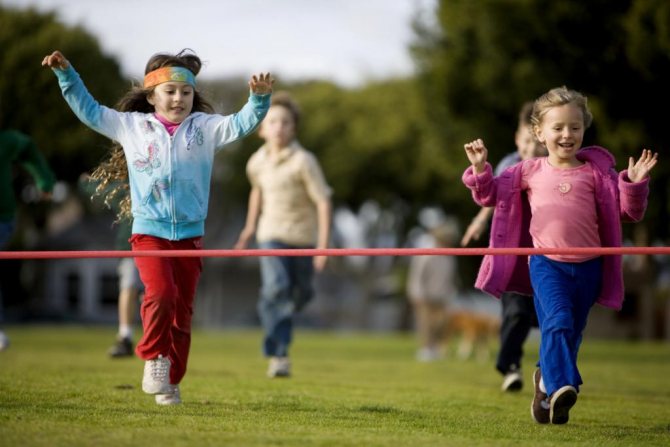
Bibliography.
- Apanasenko G.A. Physical development of children and adolescents. – Moscow: Health, 2004.
- Byleeva L.V., Korotkov I.M. "Physical education and sports." – Moscow 2002
- Zhukov M.N. Outdoor games. Textbook for students of pedagogical universities. — M. 2000
- Lomeiko V.F. Development of motor qualities in physical education lessons in grades IX. - Mn.: People's Asveta, 2005.
- Lyakh, V.I. My friend - physical education. 1st – 4th grades, 2005
- Maxson, G.B., Lyubomirsky, L.E. Methods of physical education. – Moscow: Enlightenment, 1998.
- Educational tasks of outdoor games
- Breathing exercises
- How many stages do didactic processes consist of?
- Project Risk Management
- International law: subject, method, sources and subjects
- Visual composition of a feature film
- Interaction of philosophy and religion
- Systematization of documents and compilation of a list of cases
- Cost approach in assessing the value of an enterprise (business)
- Innovation project risk management
- Non-material motivation of waiters
- Contents and specific features of entrepreneurial activity in the field of agriculture
Senior preschool age (5-7 years)
The school gym or courtyard is a great place to practice. So that the child does not constantly strive to play GTA and other online games on the computer, but finds excitement in movement, it is important for him to be properly offered alternative entertainment.
A card index of outdoor games will become an assistant in education and children's physical development. For older preschoolers, you can use the same stories as for others.

Sports competitions are also fun and interesting for children. Such children's outdoor games develop the following qualities:
- desire for an active lifestyle,
- endurance,
- developed strength,
- resourcefulness,
- collective spirit,
- reaction.
Goose, wolf and boy
What is developed and used: speed, agility.
Features: 7-10 children are needed to play, crayons are needed.
- Choose “wolf” and “boy”, the rest of the children are “geese”.
- Draw a circle on the site, the “geese” will hide in it.
- At a distance of 4-6 m (four meters is a minimum) draw another circle - the “wolf’s” house.
- The “geese” are initially in the “wolf’s” house, and the “wolf” is in the “geese” house.
- The “boy” kicks the “geese” out for a walk. They scatter across the site, running towards their house. The wolf reads a poem:
Day or night doesn't matter to me
I'm good at speed
I'm in the meadow
Here I will find all the geese.
I look scary though,
But I catch geese for a reason.
- The task of the “wolf” is to touch the “geese” and catch them all. The caught "geese" stands in the circle of the "wolf". The goal of the “geese” is to get into their home.
- Once all the “geese” are caught, the children change roles.
Children's volleyball
The famous but adapted version of volleyball is suitable for both kindergarten and any other group of children. An interesting and sporty game is played using a light playing ball.
Children have the opportunity to demonstrate individual skills because everyone plays for themselves. Healthy pastime will teach every child to healthy lifestyle. And summer is the best time for volleyball.
What else to read: Hide and seek - yard entertainment for children
Basis:
- 5-9 children stand in a circle.
- The child’s task is to hit the ball towards another player, or catch it.
- One game is given 6-8 minutes.
- Each participant needs to score as many points as possible:
- 1 point – for a caught ball,
- 2 points – for a hit ball,
- 5 points – if the ball was hit towards another participant at chest level.
- The one who scores the most points wins.
Owl
Includes both creative focus and motor activity. This team game is unusual and multi-component.
What is developed and involved: coordination, imagination.
Features: 8-9 children are needed to play, chalk is needed.
- A girl is selected from a group of children to be an “owl”.
- Since this is a team game, the remaining children are divided into two teams of “mice”.
- A round “mousetrap” with a diameter of 1 m is drawn on the asphalt.
- "Mice" are running around the "mousetrap". "Owl" says:
I'm an owl, Valentina,
I don't like raspberries,
I love catching mice
Wow, wow, tell everyone,
The sun is shining for everyone,
I will not eat…
- “Owl” names a word - any animal that an owl cannot eat. The “mice” must stop and imitate this animal.
- Whoever completes the task slowest goes into the mousetrap.
- The last mouse remaining outside the circle wins.


